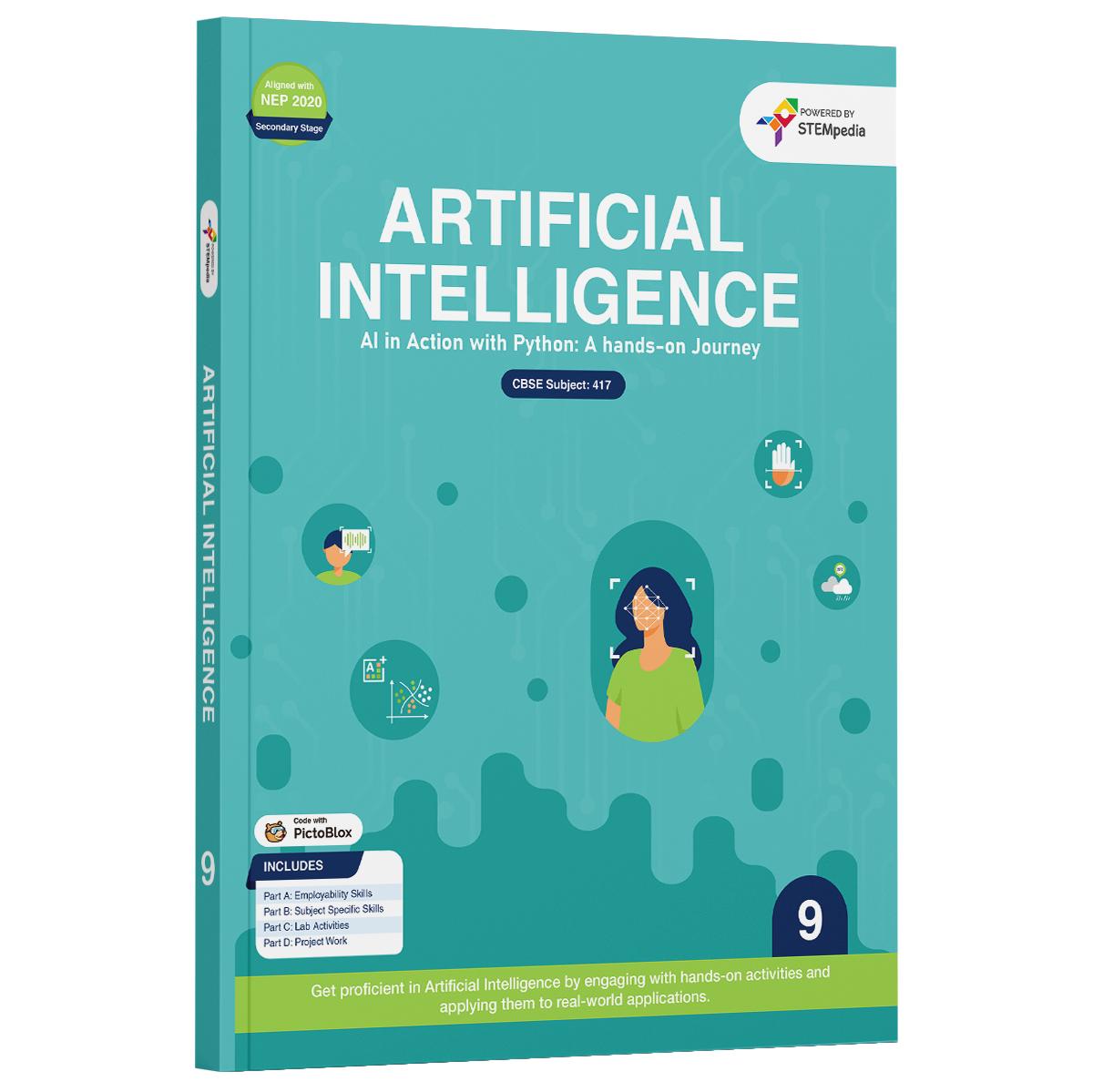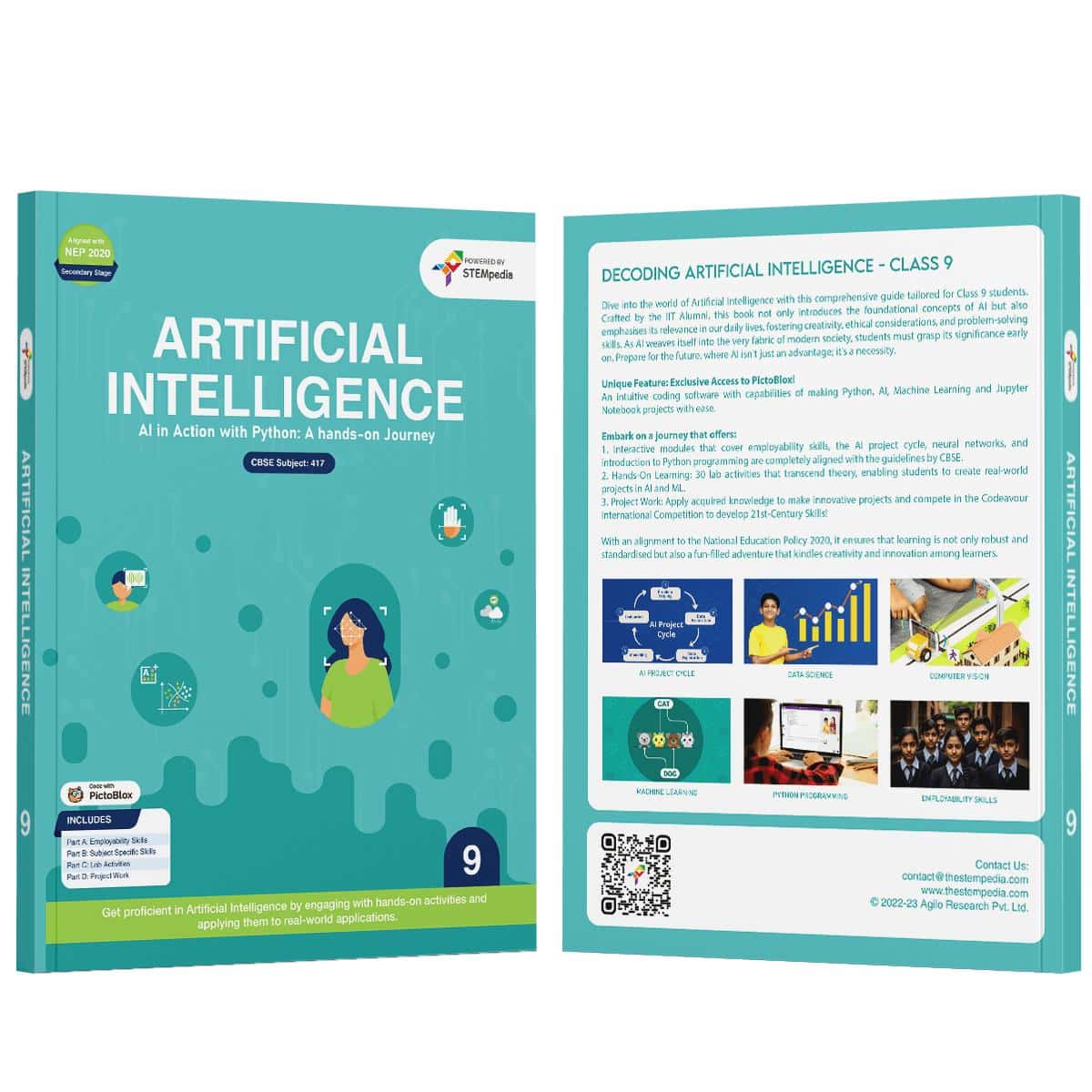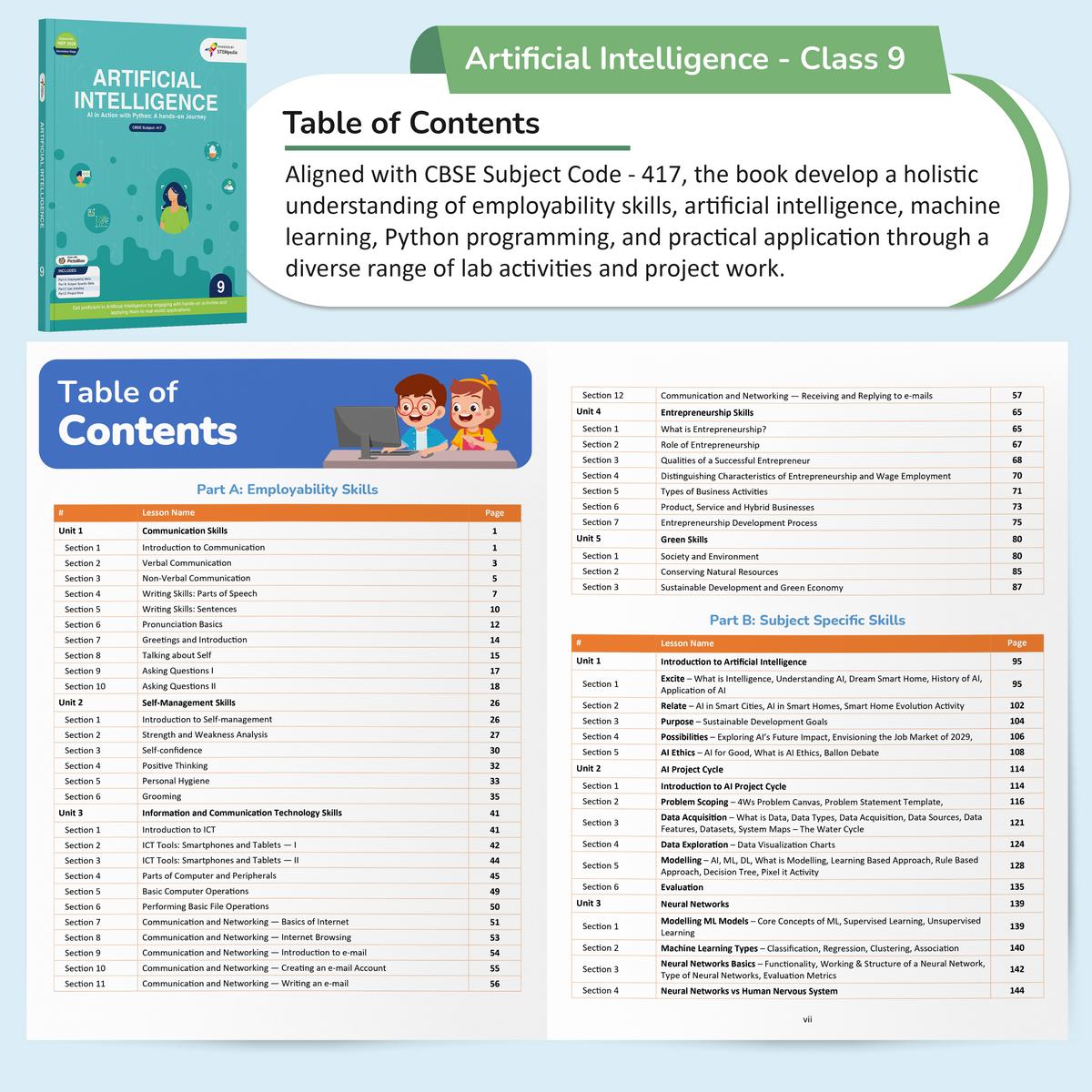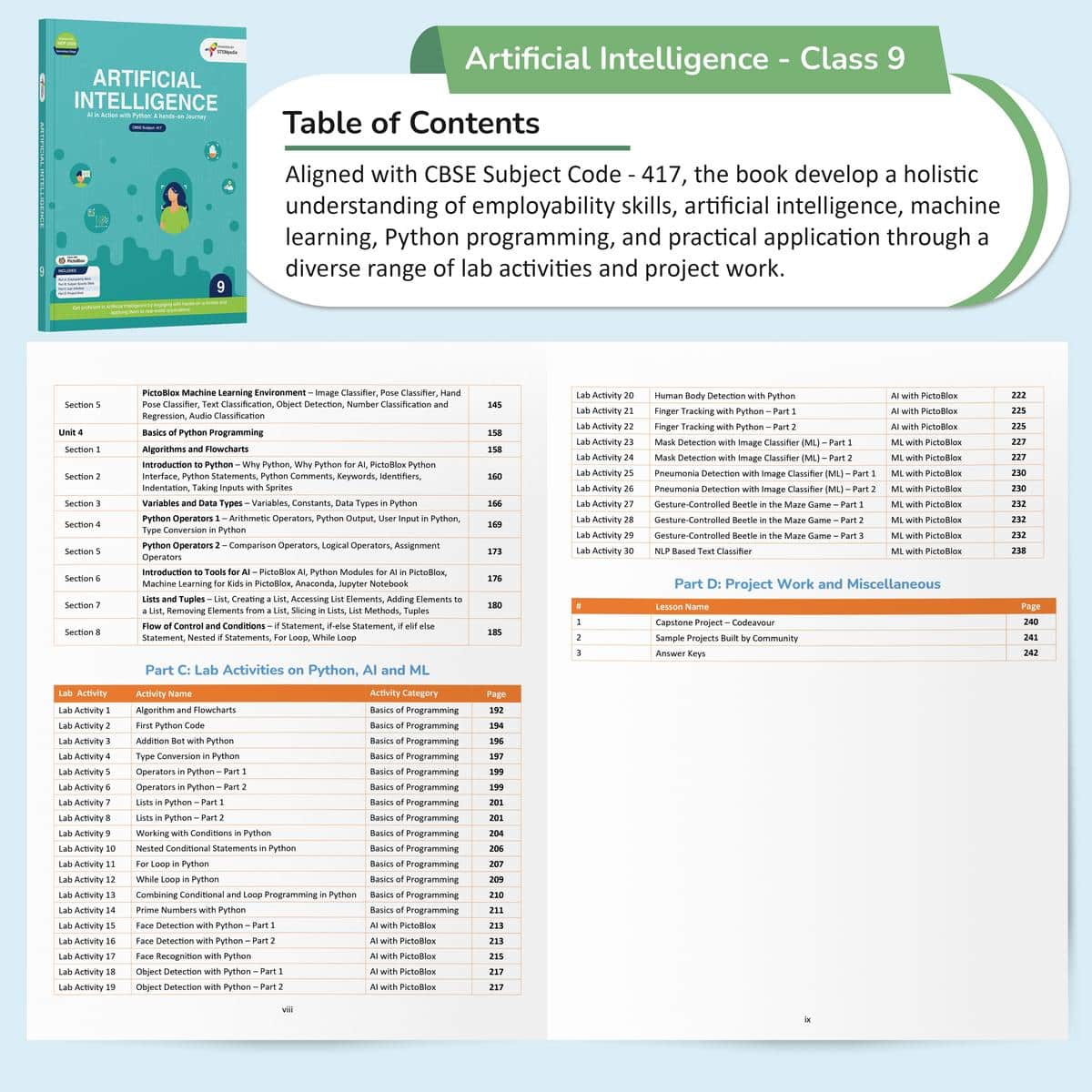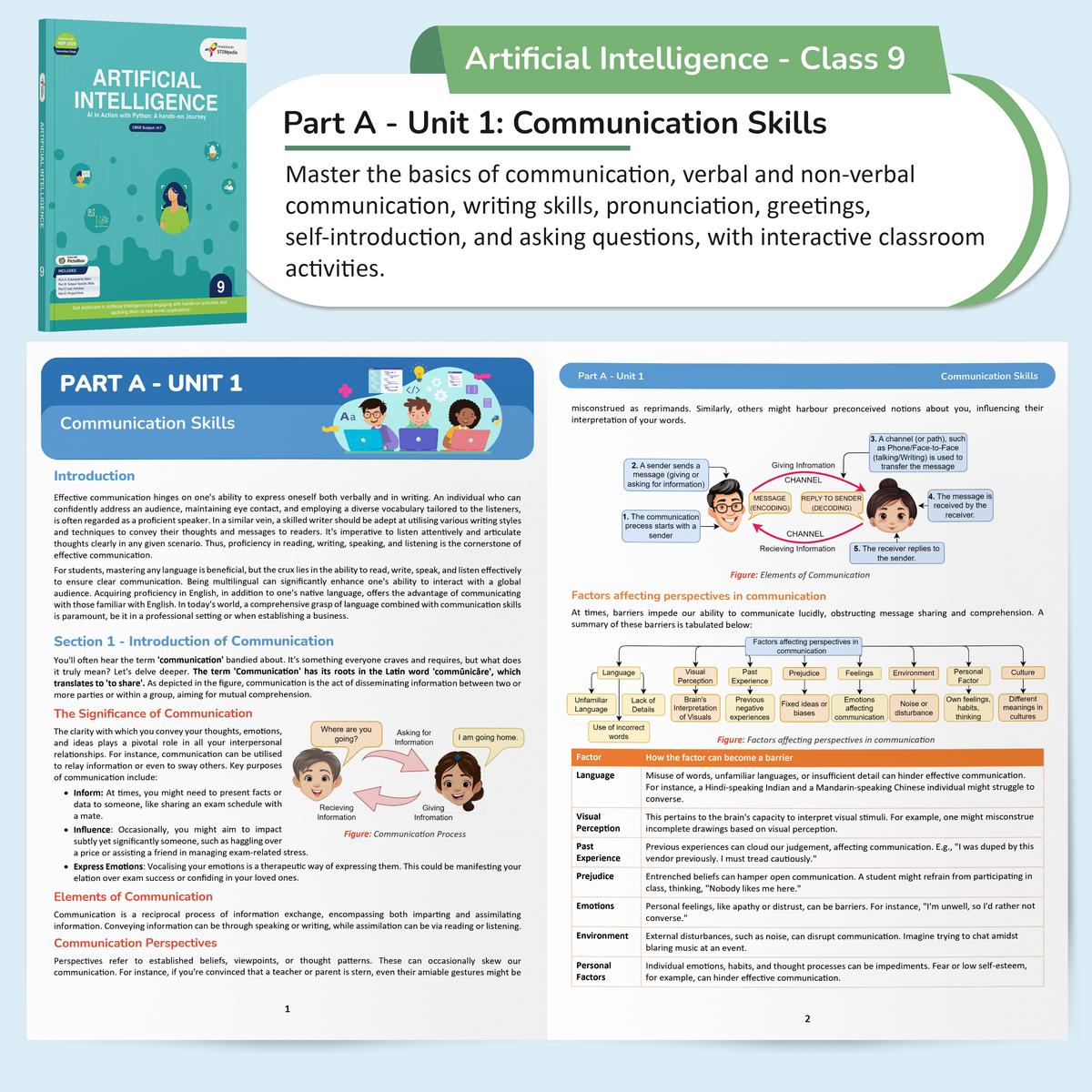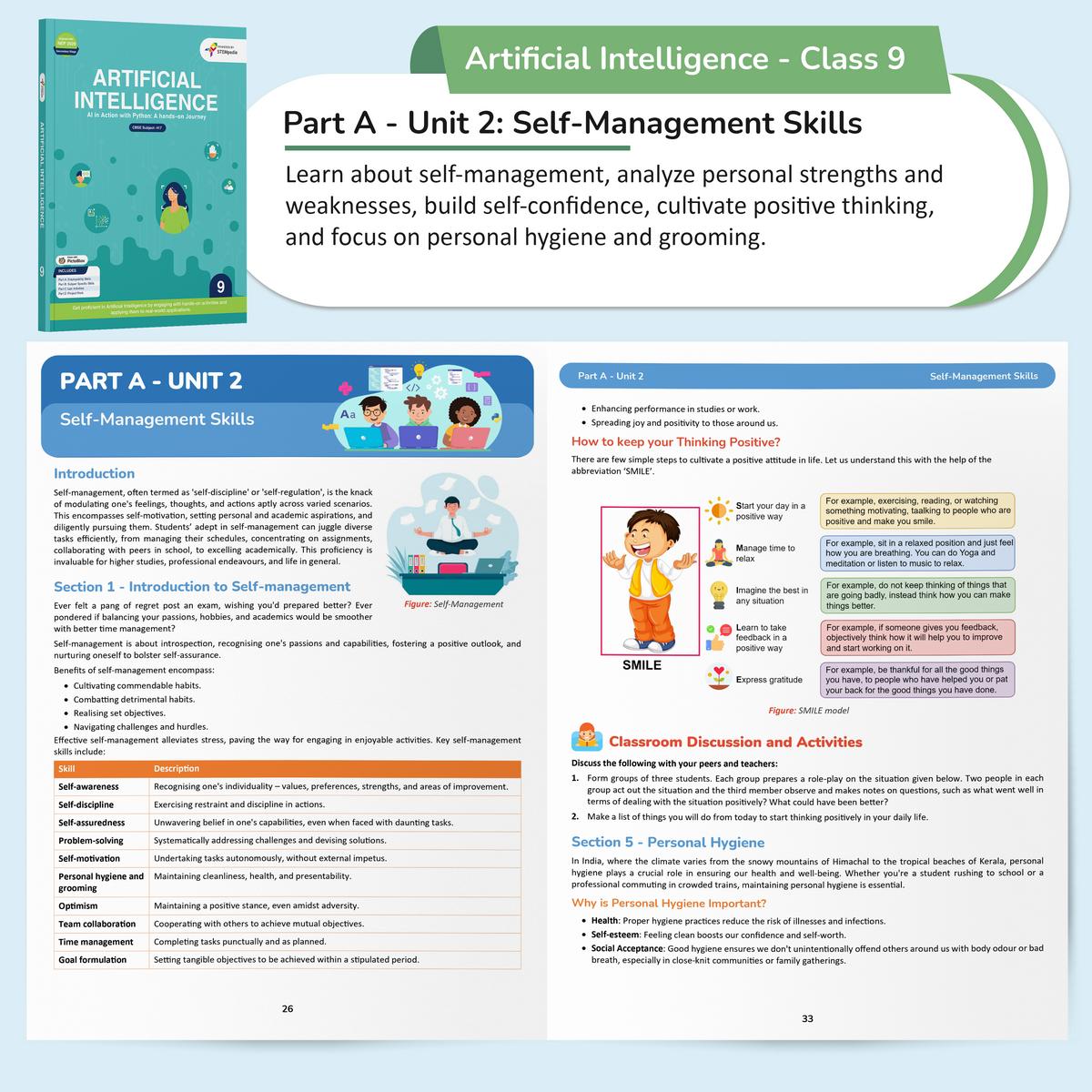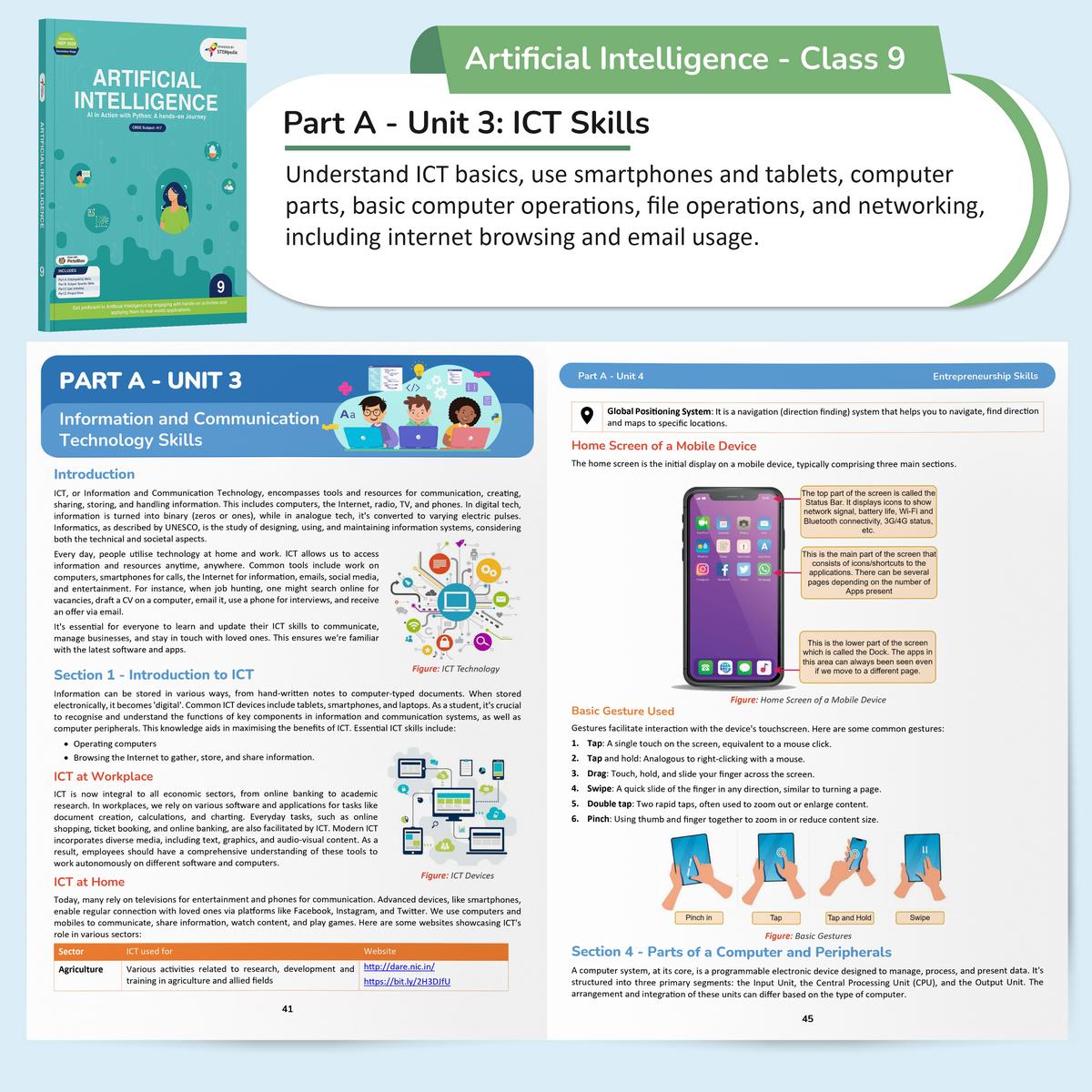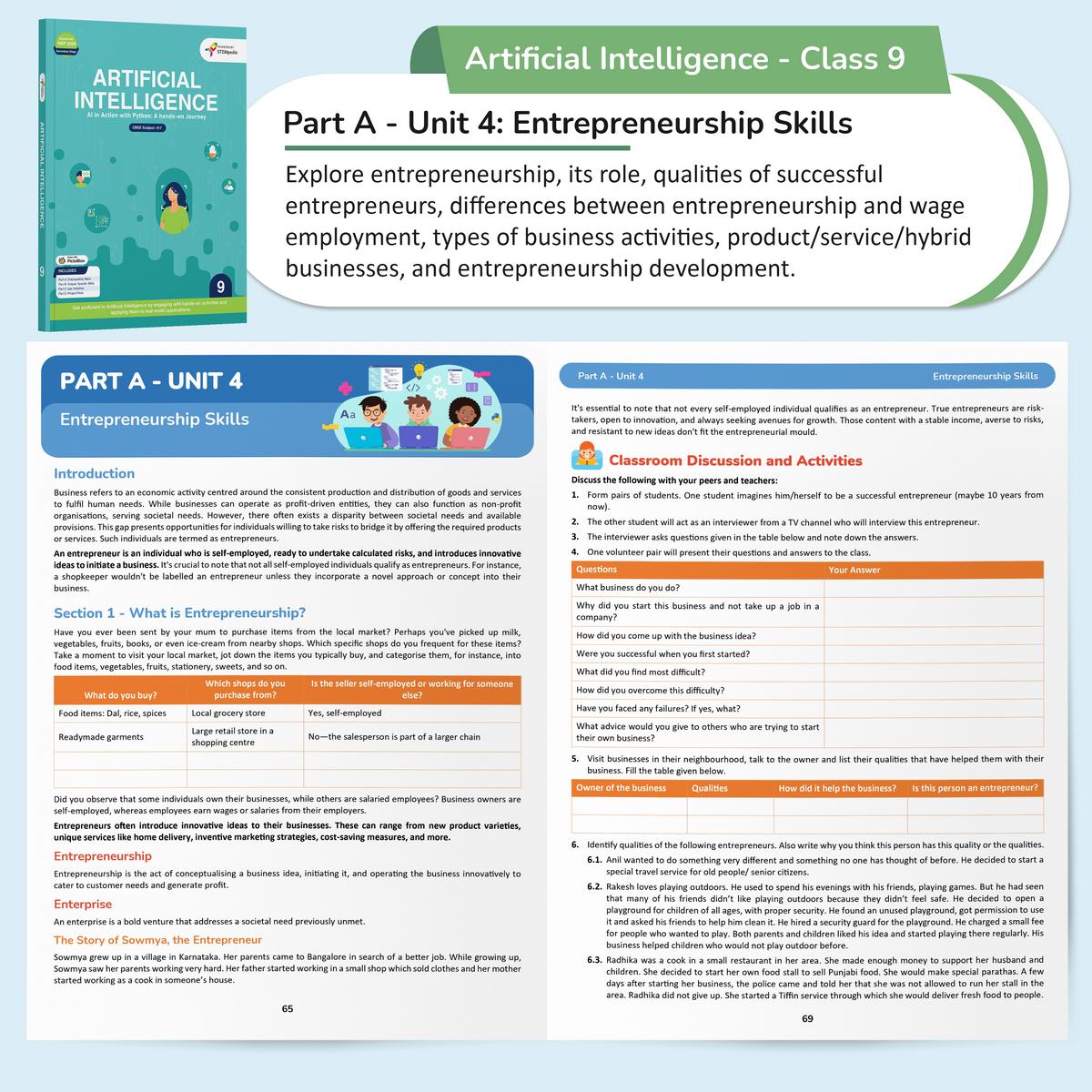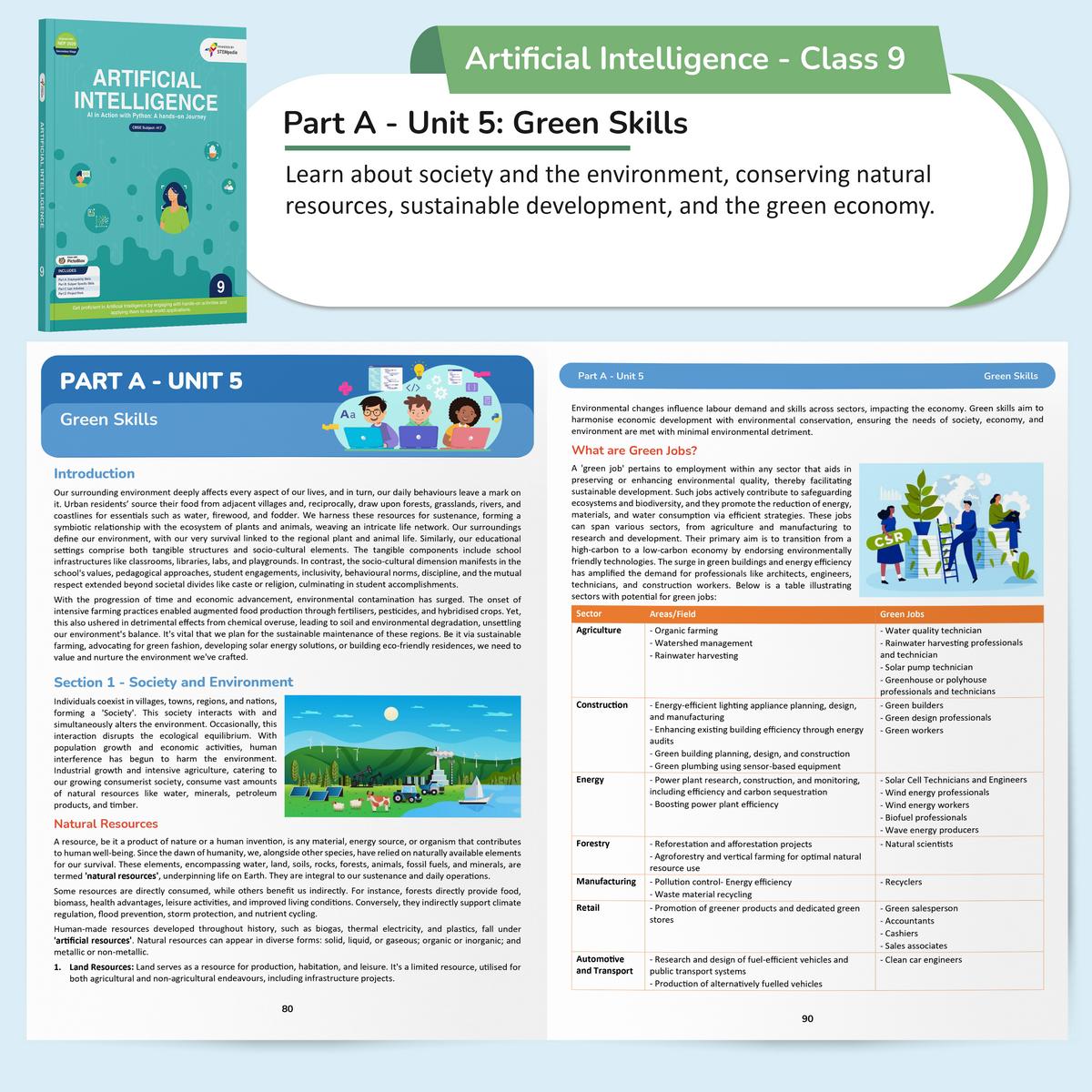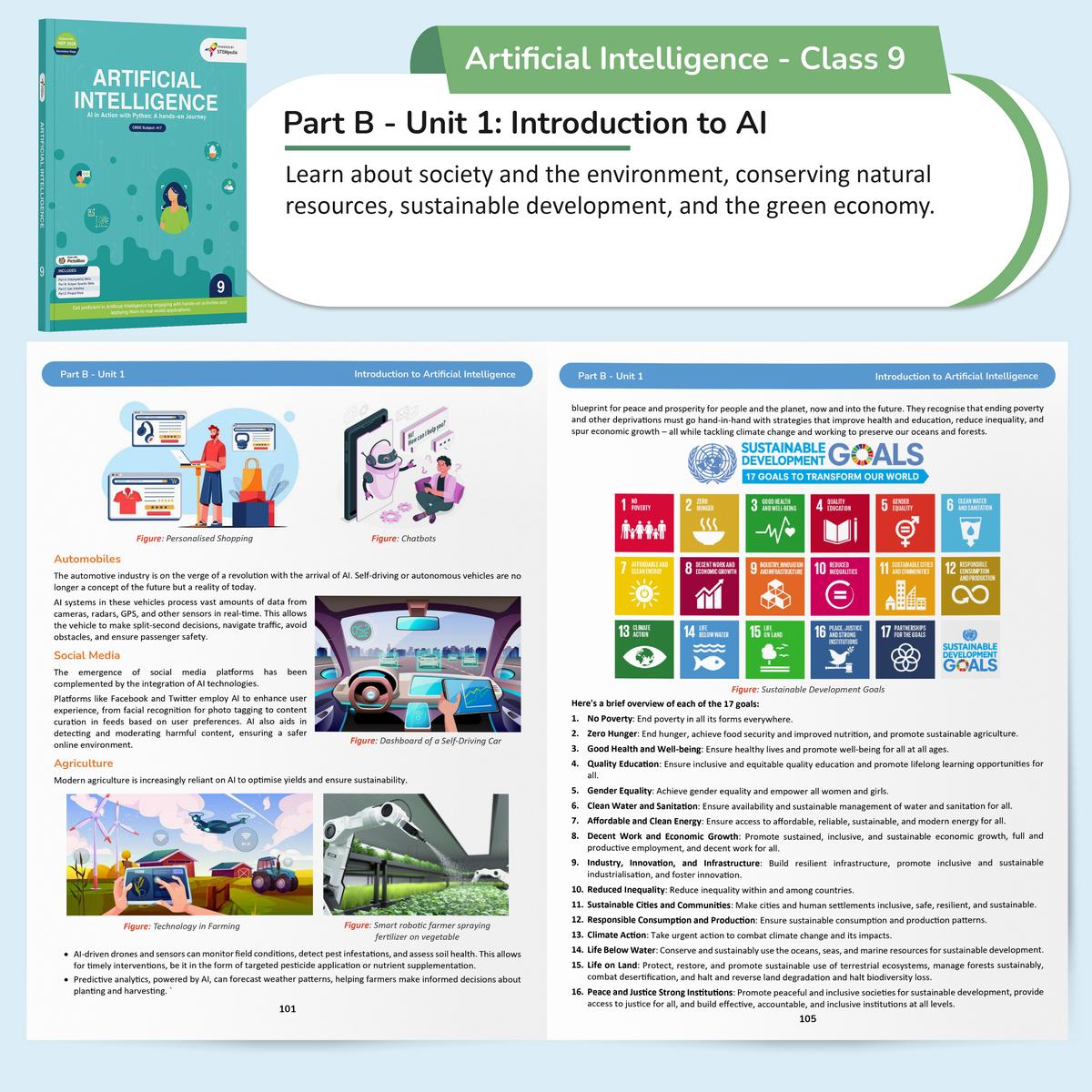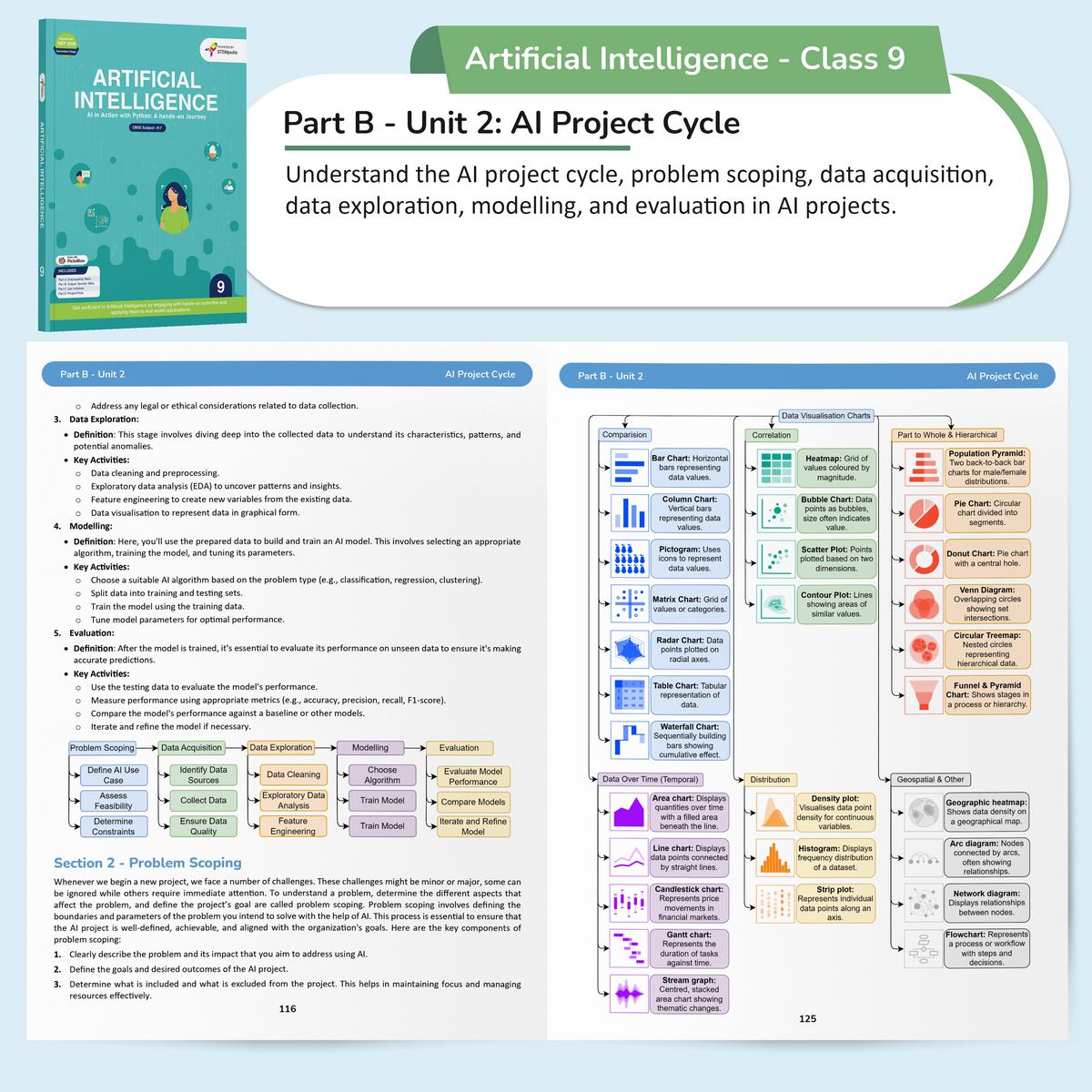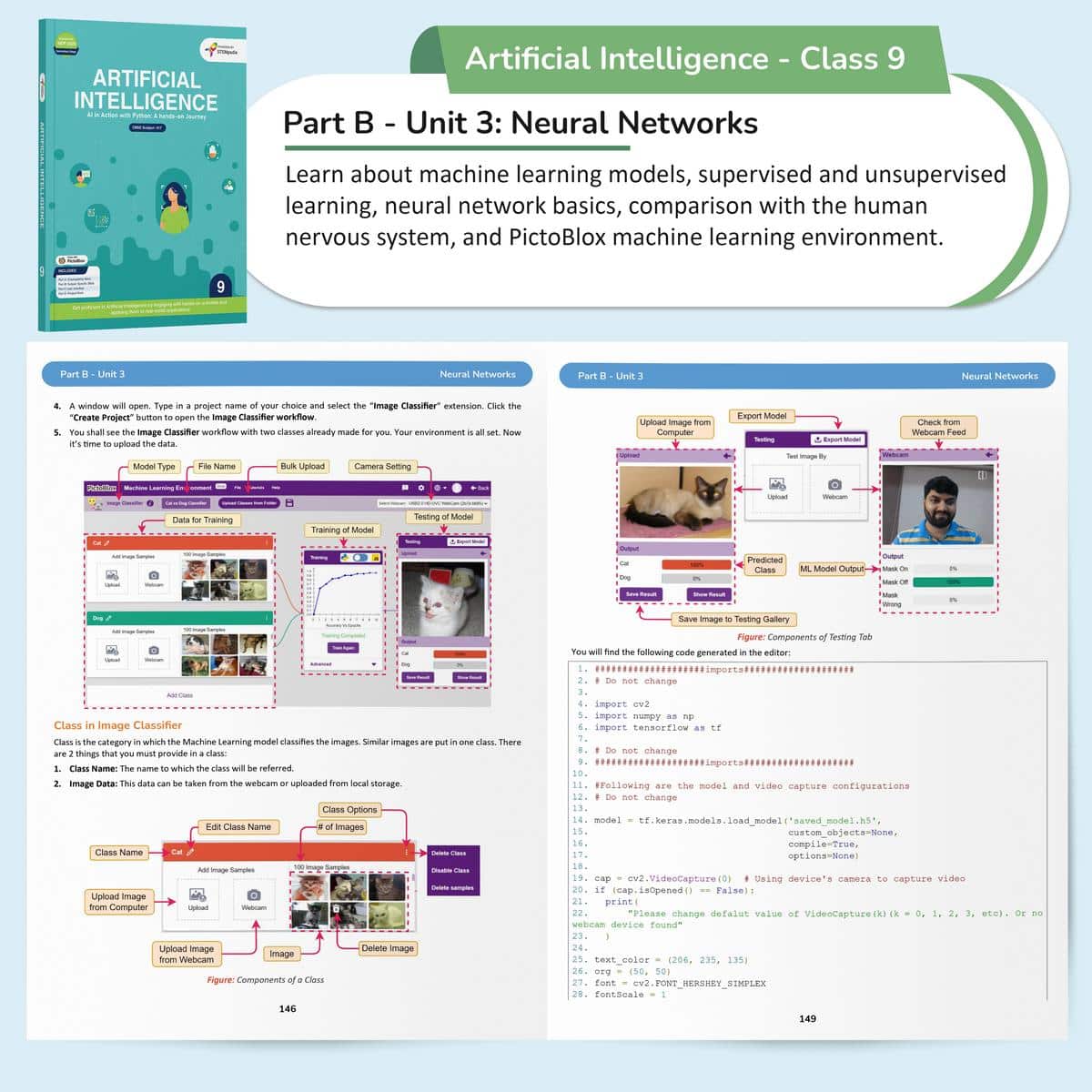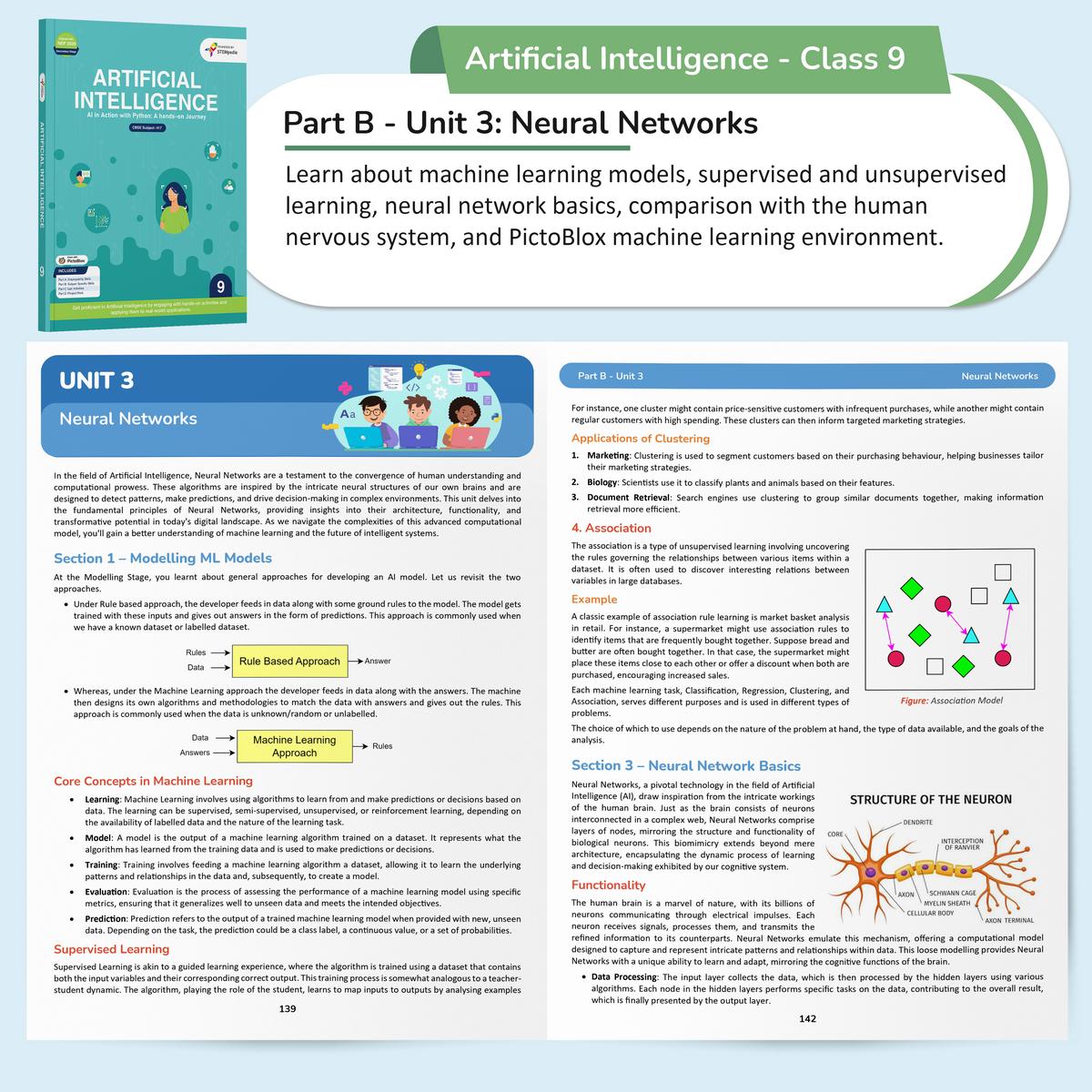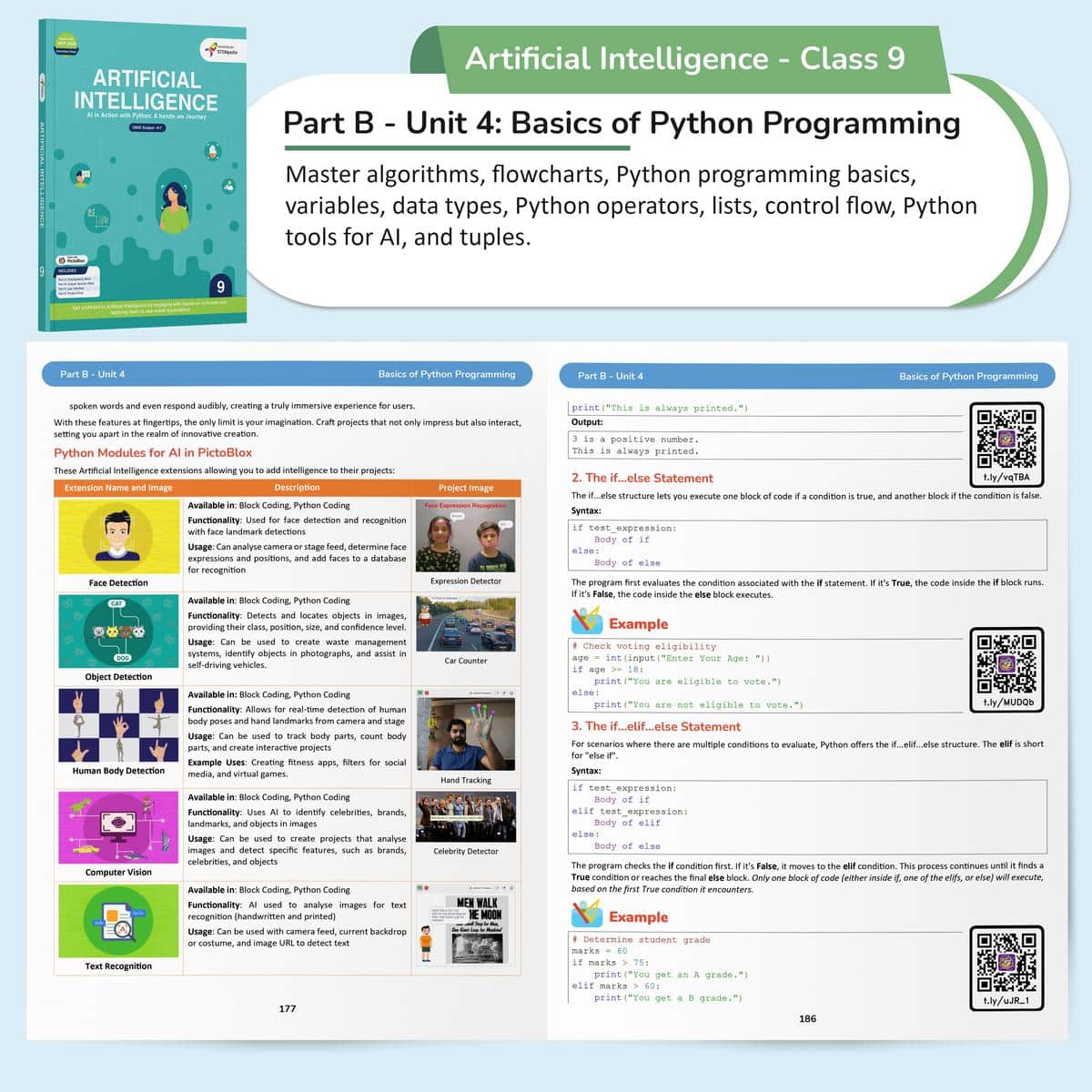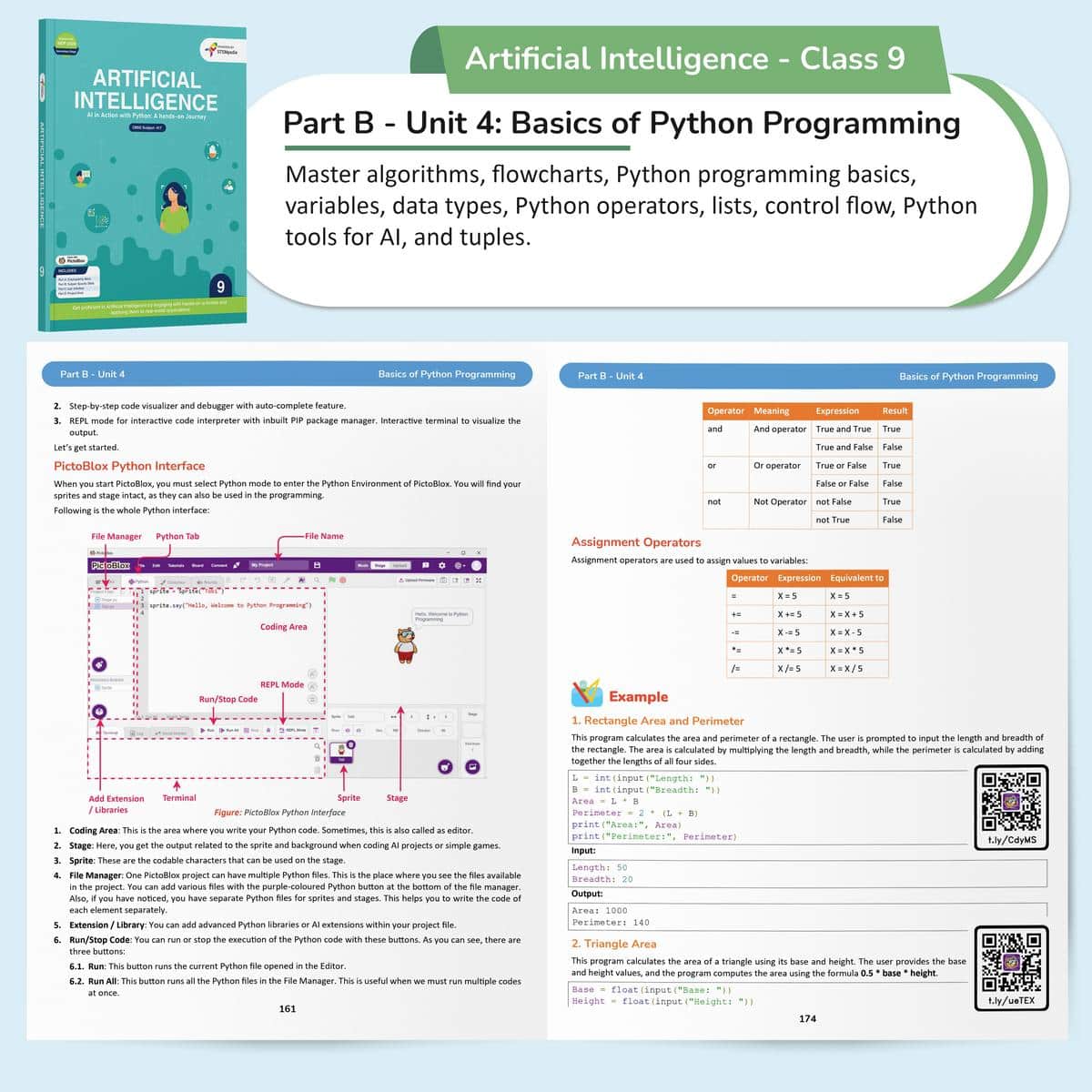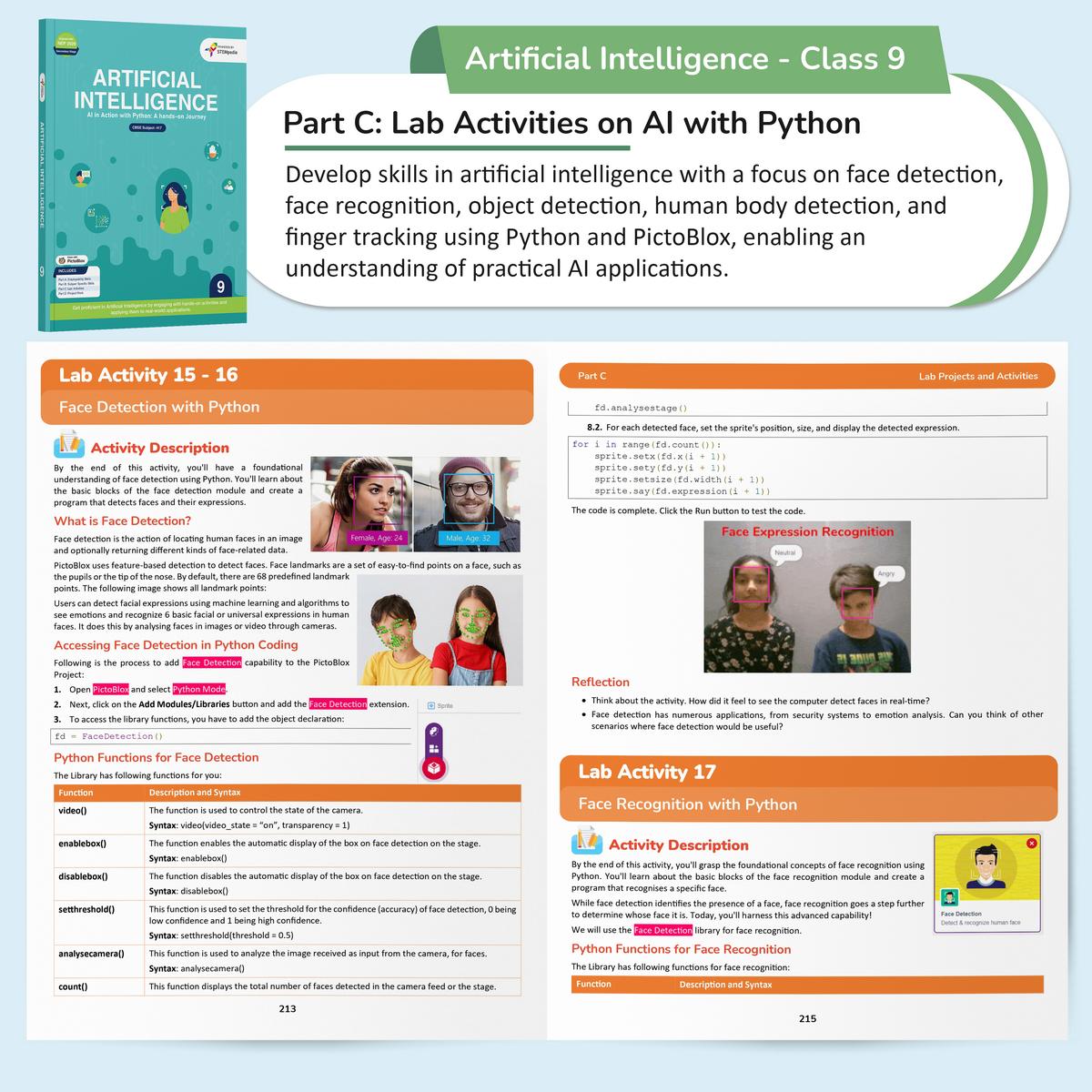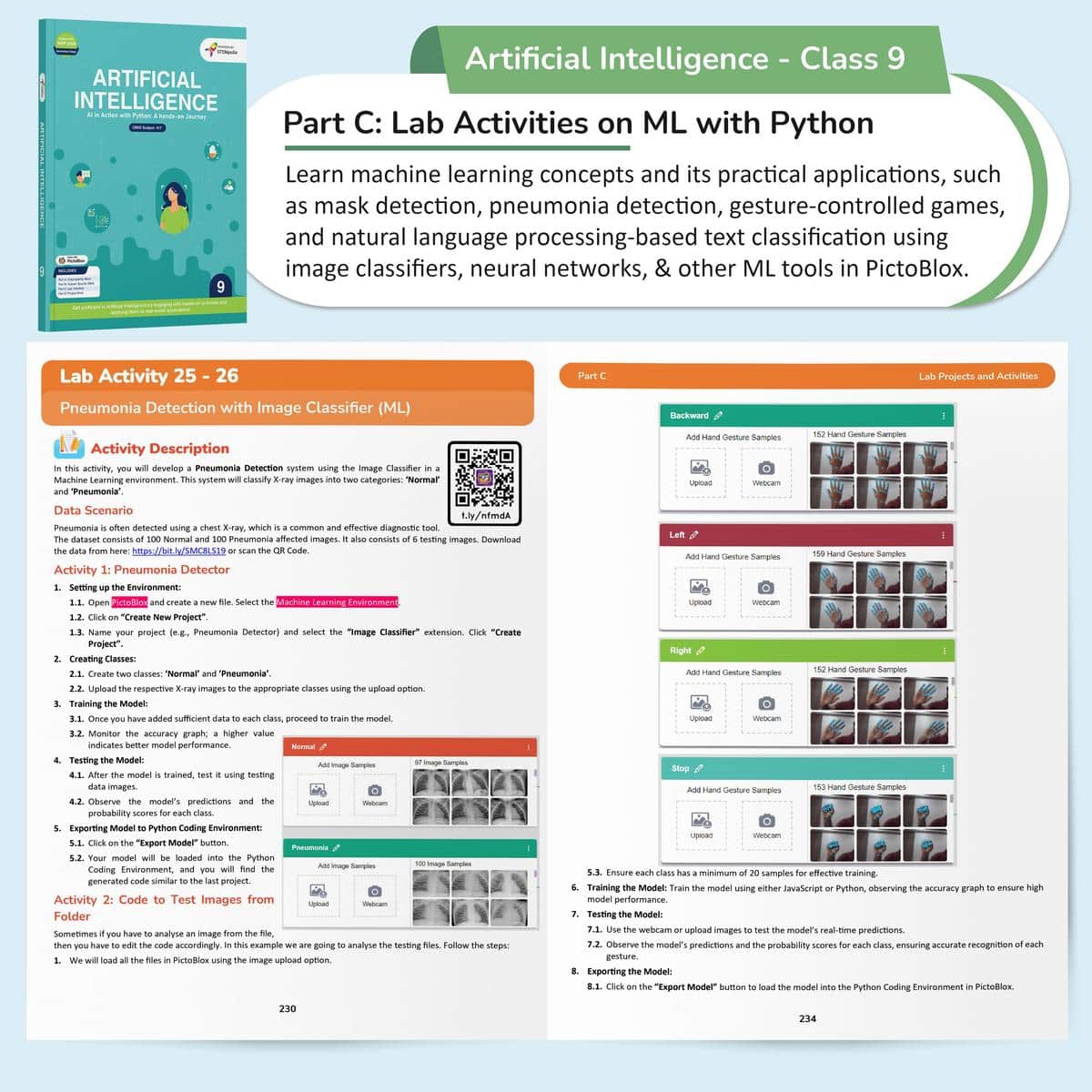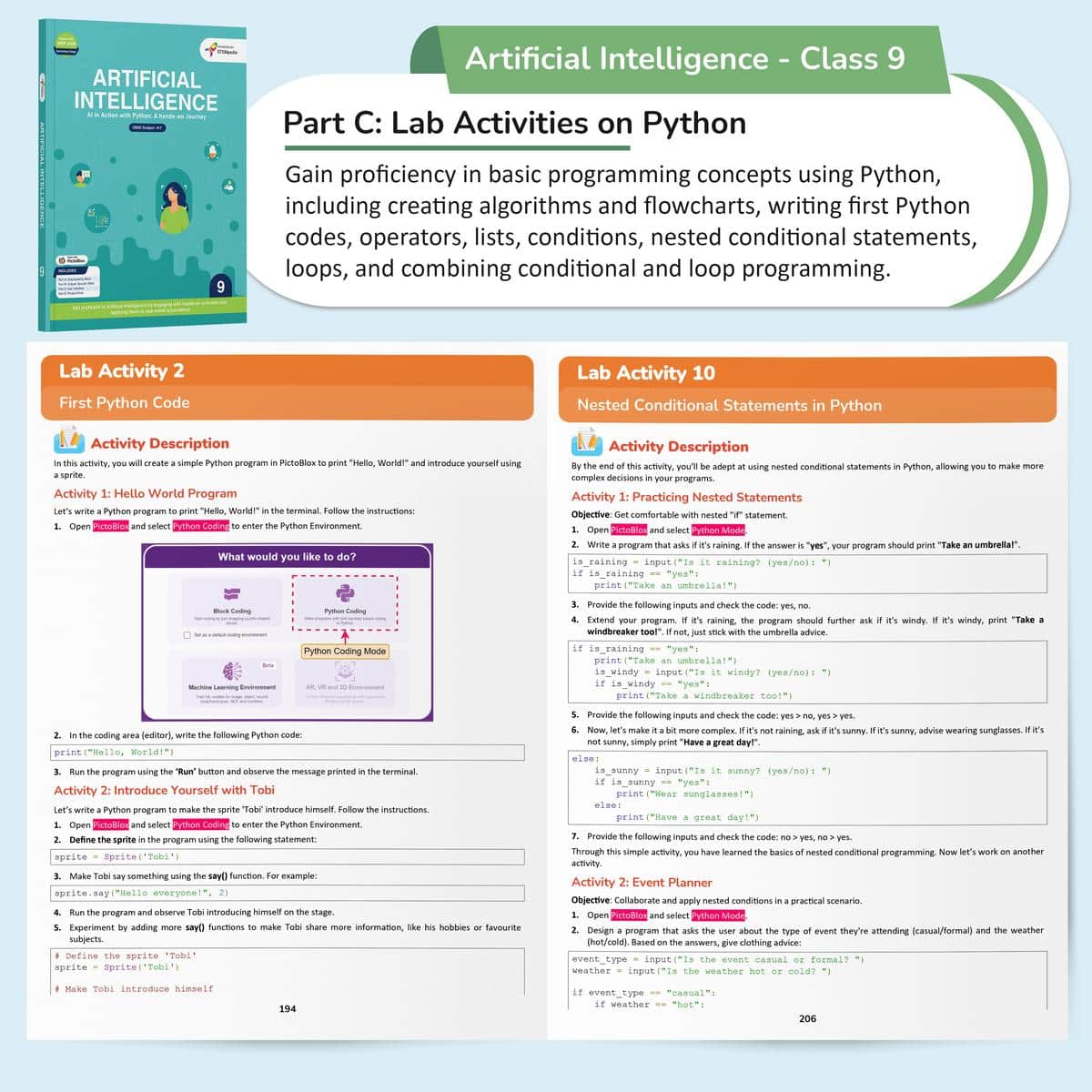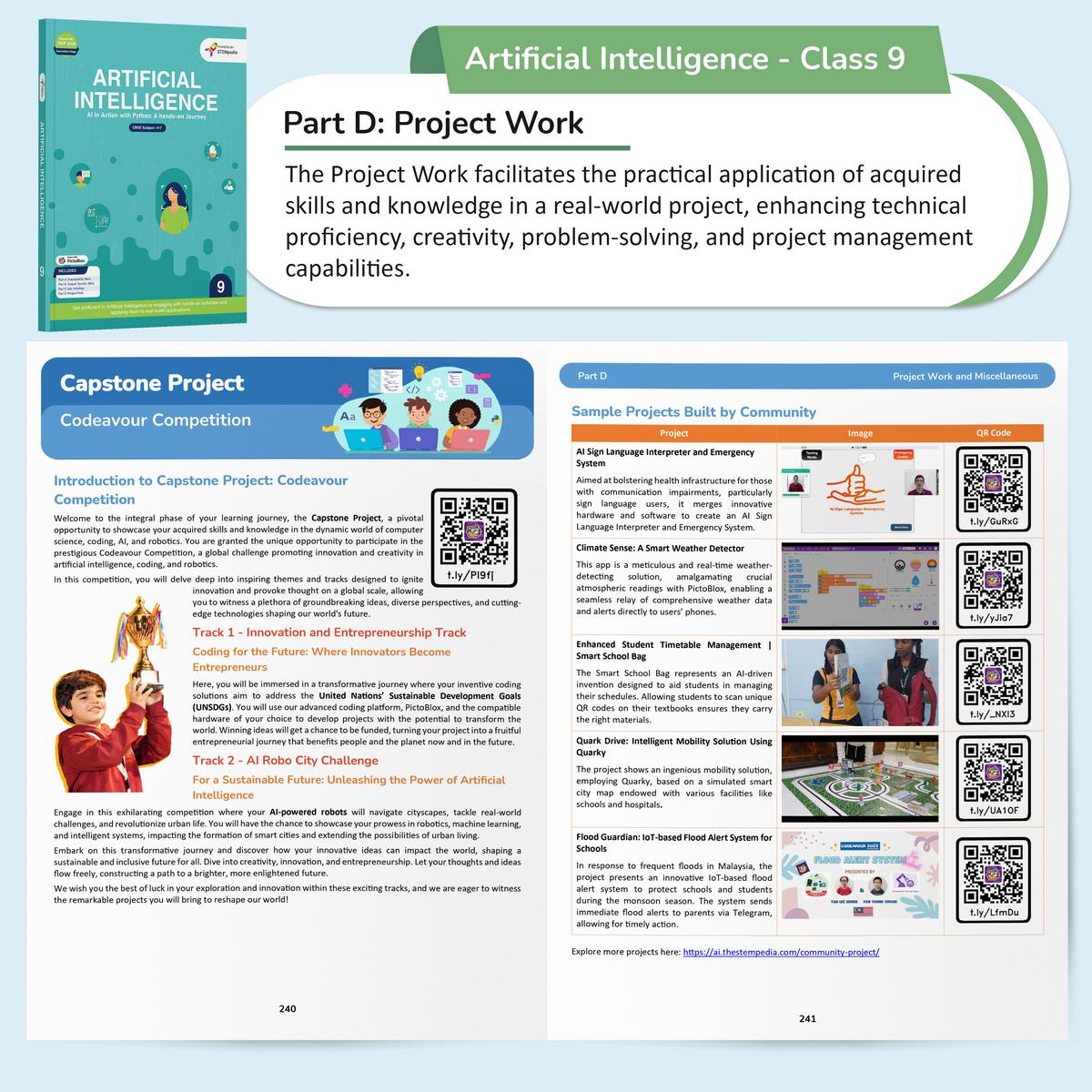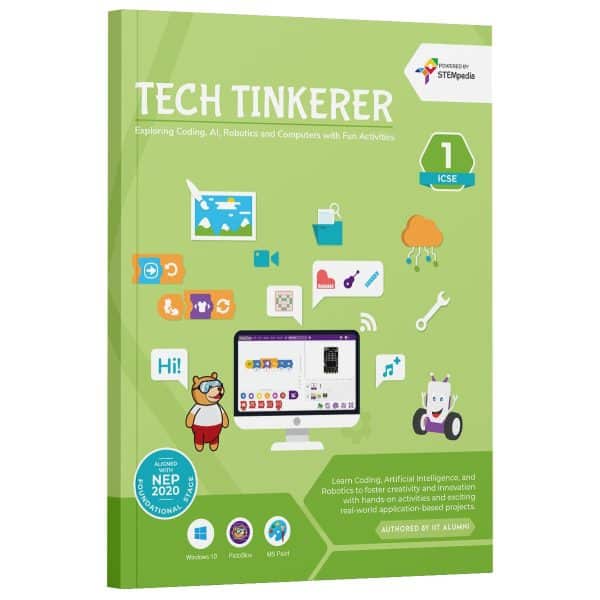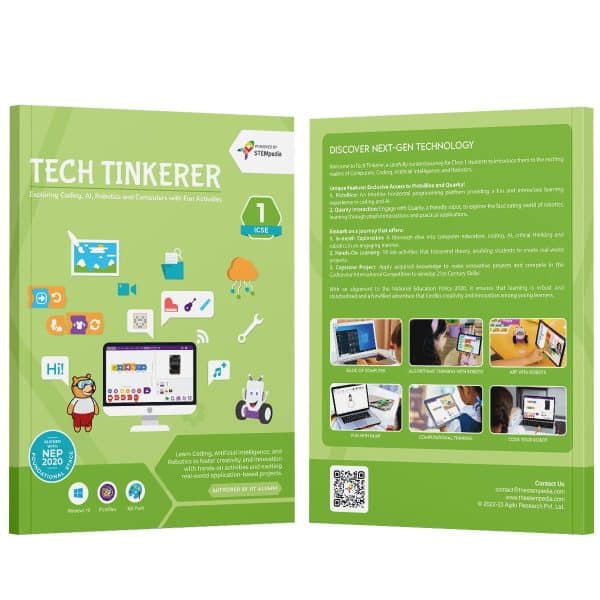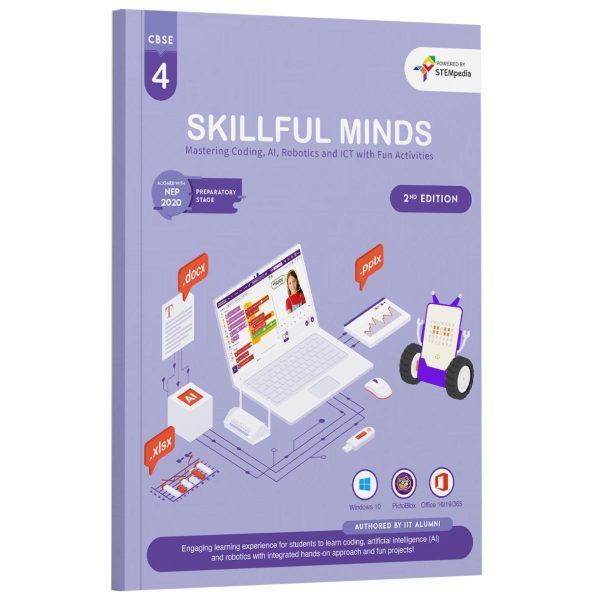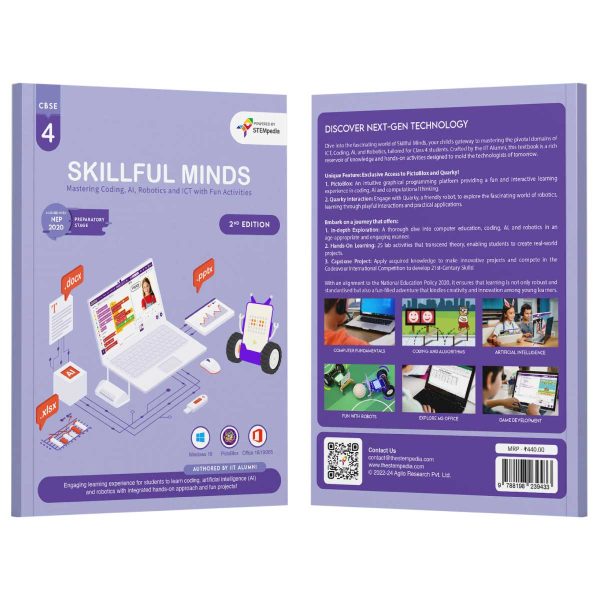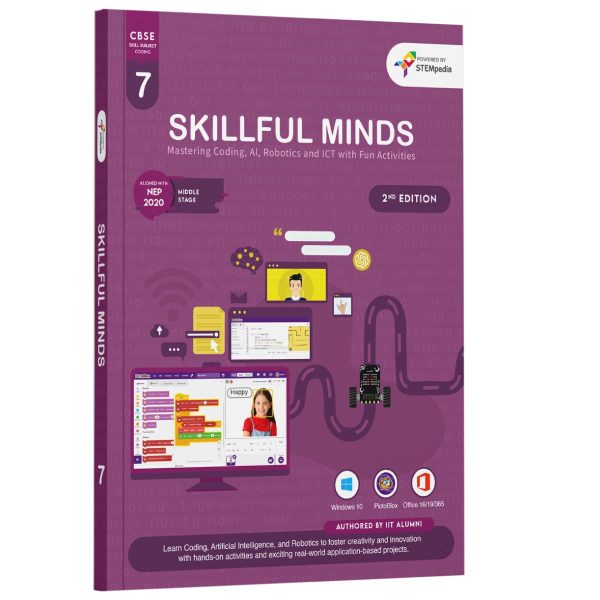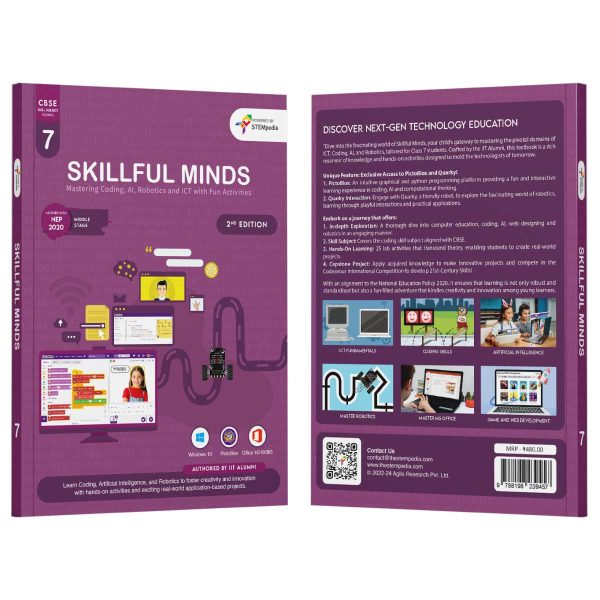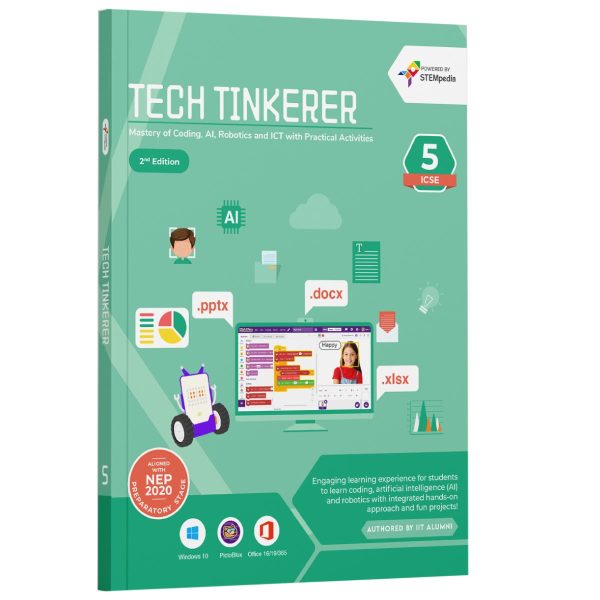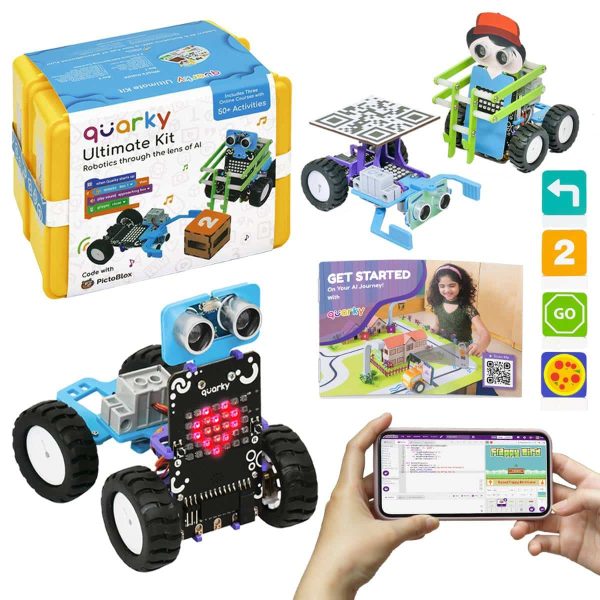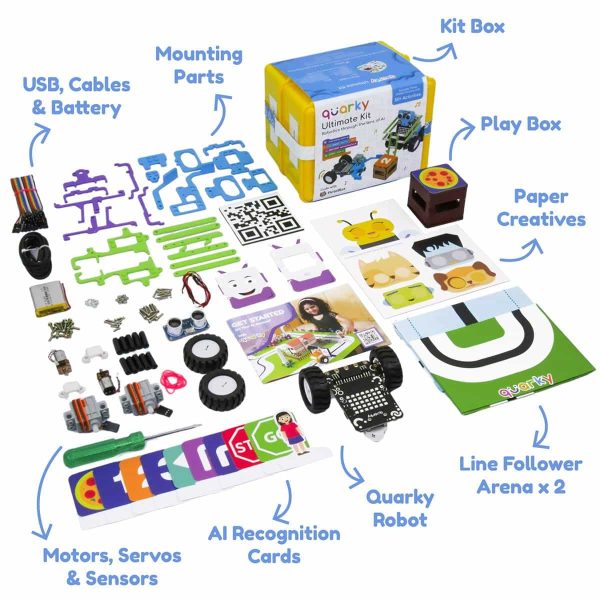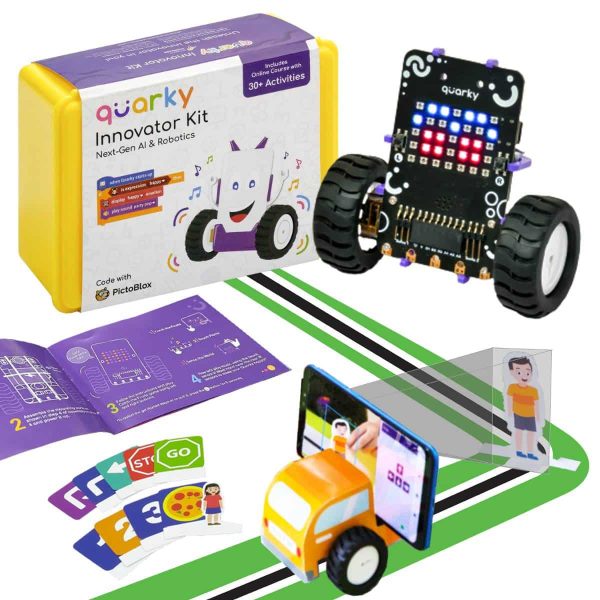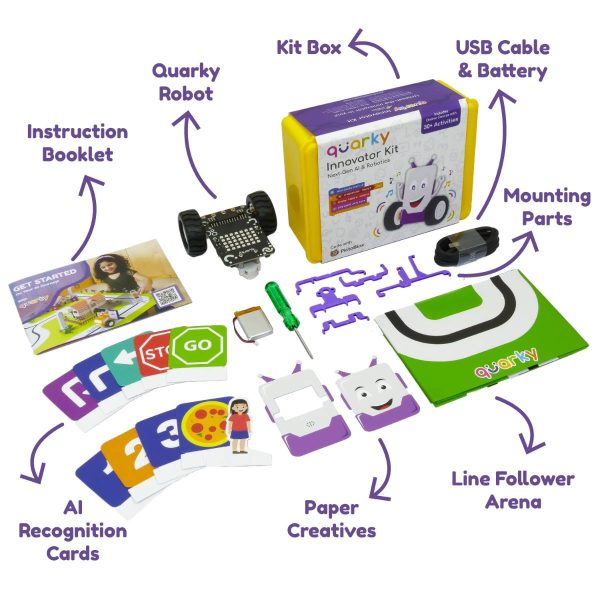Empowering Kids with the Right Future Skills
This book focuses on teaching Class 9 students about AI and how it plays a big part in our daily lives. This book aims to help students understand AI in detail and prepare them for future career paths in the fast-changing tech industry. The course includes theory and practical skills, focusing on learning Python programming and developing AI projects.
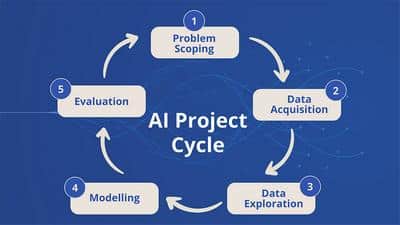
AI Project Cycle

Data Science
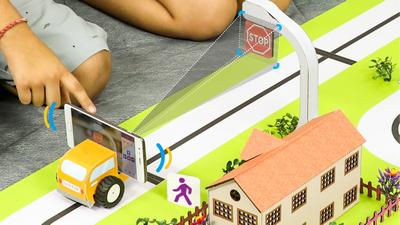
Computer Vision

AI Project Cycle

Data Science

Computer Vision

Machine Learning

Python Programming

Employbility Skills

Machine Learning

Python Programming

Employbility Skills
Inside the Book
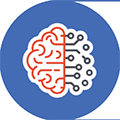
Employability Skills
Emphasizing holistic development, the curriculum covers essential employability skills such as communication, self-management, and ICT skills.
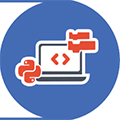
CBSE Aligned Skill Subjects
Aligned with CBSE AI subject (Code 417), assisting students in excelling in their exams and build tech competency.
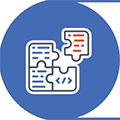
Activity-Based Learning
Incorporating 30 hands-on activities and theme-based learning that make learning both fun and intellectually stimulating.

Innovative Curriculum Design
Tailored specifically for Class 9 students, the curriculum integrates advanced AI concepts with Python programming, offering a cutting-edge learning experience.

PictoBlox AI Software
Learn the art of coding through Python coding in PictoBlox, a premier tool for young learners. Students also receive 5000 AI credits for PictoBlox.

Codeavour Competition
Exclusive access to Codeavour – the AI and Robotics Competition, with the opportunity to represent India on the global stage at Dubai.
Software and Hardware Used

Windows 10

PictoBlox Python Coding

PictoBlox AI

PictoBlox Machine Learning
Part A - Employbility Skills
This section covers essential skills like communication, self-management, ICT skills, entrepreneurial skills, and green skills. It is designed to enhance students’ overall personality and make them ready for future career challenges.
| Unit | Name | Number of Sections | Description |
|---|---|---|---|
| 1 | Communication Skills | 10 | This unit covers the basics of communication, focusing on verbal and non-verbal methods, writing skills including parts of speech and sentence construction, pronunciation basics, effective greetings, self-introduction, and the art of asking questions. |
| 2 | Self-Management Skills | 6 | It delves into self-management, exploring self-awareness through strength and weakness analysis, building self-confidence, fostering positive thinking, and emphasizing the importance of personal hygiene and grooming. |
| 3 | Information and Communication Technology Skills | 12 | This unit introduces ICT skills, covering the use of smartphones and tablets, understanding computer parts and peripherals, basic computer operations, fundamental file operations, and the basics of internet usage including browsing, email communication, and email account creation. |
| 4 | Entrepreneurship Skills | 7 | It provides insights into entrepreneurship, exploring its definition, role, the qualities of successful entrepreneurs, differentiating between entrepreneurship and wage employment, types of business activities, and the entrepreneurship development process. |
| 5 | Green Skills | 3 | This unit focuses on environmental awareness and green skills, discussing society's relationship with the environment, ways to conserve natural resources, and the concept of sustainable development and green economy. |
Part B: Subject Specific Skills
The students learn about the main ideas of AI, like what it is, how to do a project, neural networks, and how to use Python. This is the most important part of the course, and it teaches them a lot about AI basics.
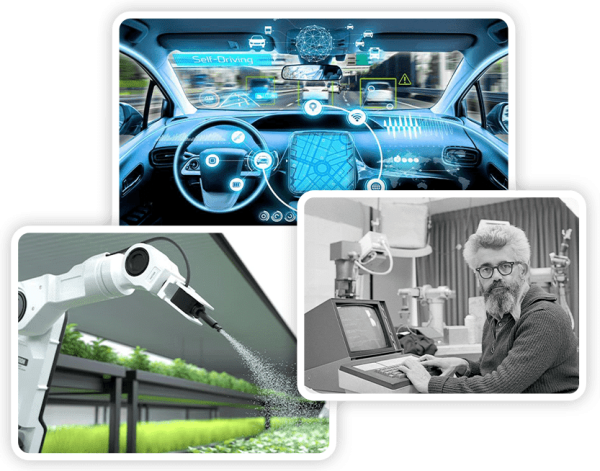
Unit 1: Introduction to Artificial Intelligence
- Section 1: Explores the concept of intelligence, the history and applications of AI, and envisioning AI in smart homes.
- Section 2: Discusses AI in smart cities and homes, including activities related to the evolution of smart homes.
- Section 3: Focuses on AI’s role in achieving Sustainable Development Goals.
- Section 4: Delves into the future impact of AI and its potential influence on the job market by 2029.
- Section 5: Addresses AI ethics, discussing the principles of AI for good and conducting a balloon debate to explore ethical considerations.
Unit 2: AI Project Cycle
- Section 1: Introduces the AI project cycle, outlining its stages and significance.
- Section 2: Covers problem scoping in AI projects, including problem canvas and statement formulation.
- Section 3: Discusses data acquisition in AI, exploring different data types, sources, and features.
- Section 4: Focuses on data exploration, emphasizing data visualization charts.
- Section 5: Examines AI modelling, differentiating between learning-based and rule-based approaches, and introducing decision trees.
- Section 6: Explores the evaluation phase in the AI project cycle, emphasizing its importance.
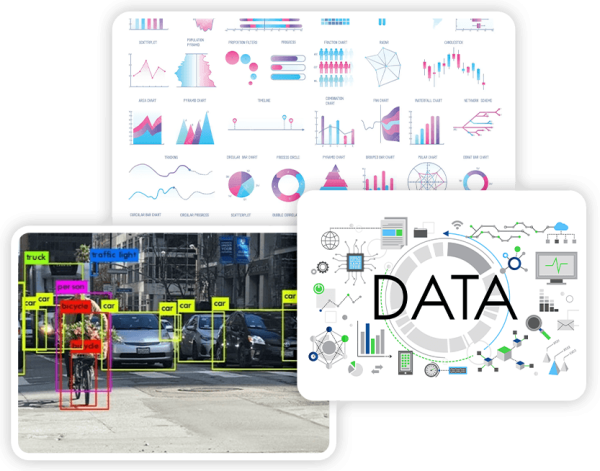
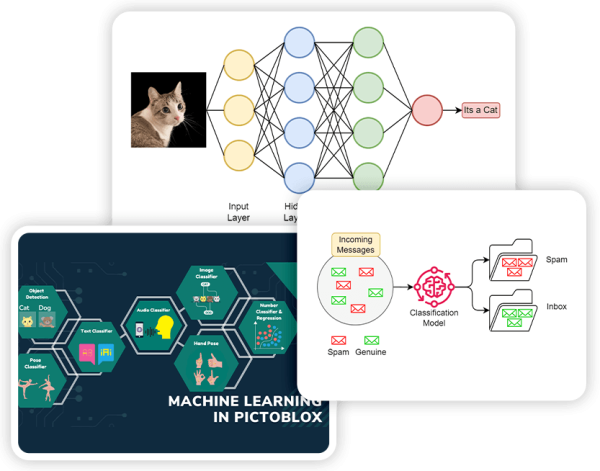
Unit 3: Neural Networks
- Section 1-2: Covers core concepts of machine learning, including supervised and unsupervised learning, and various types like classification, regression, clustering, and association.
- Section 3: Provides a basic understanding of neural networks, their functionality, types, and evaluation metrics.
- Section 4: Compares neural networks with the human nervous system.
- Section 5: Introduces the PictoBlox Machine Learning environment, including various classifiers and ML models.
Unit 4: Basics of Python Programming
- Section 1: Discusses algorithms and flowcharts as essential programming tools.
- Section 2: Provides an introduction to Python, highlighting its relevance to AI and basics of programming in PictoBlox.
- Section 3-4: Focuses on Python basics, including variables, data types, and operators (arithmetic, comparison, logical, and assignment).
- Section 5: Continues with Python operators, emphasizing comparison, logical, and assignment types.
- Section 6: Introduces tools for AI programming in Python, including PictoBlox AI and Python modules.
- Section 7: Explores lists and tuples in Python, including their creation, manipulation, and methods.
- Section 8: Discusses the flow of control and conditions in Python, covering various statements and loops.
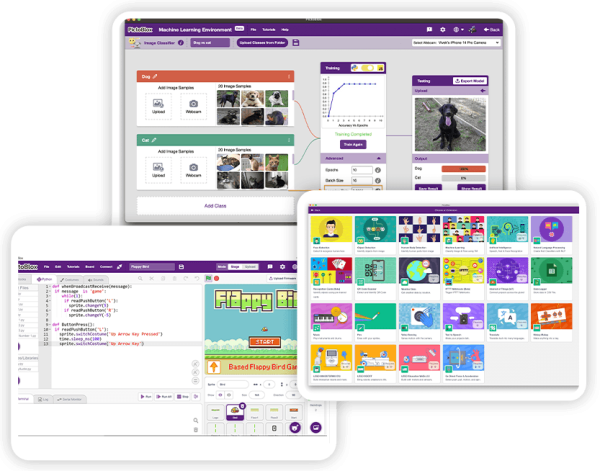
Part C - Practical Work
Practical application of theoretical knowledge is emphasised in this section. It includes extensive lab activities, focusing on Python programming and machine learning, to enhance students’ hands-on experience.
| Lab Activity | Name | Category | Activity Description | Learning Outcome |
|---|---|---|---|---|
| 1 | Algorithm and Flowcharts | Basics of Programming | Understand the basics of algorithms and flowcharts through real-life scenarios. Covered in Part B – Unit 4 – Section 1. | Develop a foundational understanding of algorithms and flowcharts and their application in programming. |
| 2 | First Python Code | Basics of Programming | Create a simple Python program in PictoBlox to print "Hello, World!" and introduce yourself using a sprite. | Learn to write and execute basic Python code and understand its practical application. |
| 3 | Addition Bot with Python | Basics of Programming | Understand basic Python syntax and create an addition bot using PictoBlox. | Gain proficiency in basic Python syntax and develop a functional addition bot. |
| 4 | Type Conversion in Python | Basics of Programming | Understand and practise implicit and explicit type conversion in Python. | Master the concepts of type conversion in Python, enhancing programming flexibility and functionality. |
| 5 & 6 | Operators in Python | Basics of Programming | Understand and practise using operators in Python through real-world examples. | Acquire comprehensive knowledge of Python operators and their usage in various scenarios. |
| 7 & 8 | Lists in Python | Basics of Programming | Practice lists in Python, focusing on creation, manipulation, and various operations. | Develop skills in managing and manipulating lists in Python, a crucial data structure. |
| 9 | Working with Conditions in Python | Basics of Programming | Use the "if-elif-else" statement in Python to make decisions in programs. | Learn to implement conditional logic in Python for decision-making in programming. |
| 10 | Nested Conditional Statements in Python | Basics of Programming | Become adept at using nested conditional statements in Python, enabling more complex decision-making in programs. | Advance skills in conditional logic with nested statements for complex programming scenarios. |
| 11 | For Loop in Python | Basics of Programming | Become proficient in using the 'for' loop in Python, enabling repeated code execution with ease. | Master the 'for' loop for efficient and repetitive code execution in Python. |
| 12 | While Loop in Python | Basics of Programming | Become adept at using the 'while' loop in Python, to repeatedly execute code as long as a condition remains true. | Gain expertise in the 'while' loop for dynamic and condition-based code execution. |
| 13 | Combining Conditional and Loop Programming in Python | Basics of Programming | Become proficient in using both conditional statements and loops. Create a program listing numbers divisible by a user-entered number between 1 and 100. | Enhance ability to combine loops and conditional statements for sophisticated programming solutions. |
| 14 | Prime Numbers with Python | Basics of Programming | Become adept at combining conditional statements and loops to identify prime numbers within a user-specified range. | Develop skills in creating algorithms for identifying prime numbers using Python. |
| 15 & 16 | Face Detection with Python | AI with PictoBlox | Gain a foundational understanding of face detection using Python. Learn about face detection module functions and create a program detecting faces and expressions. | Acquire basic skills in face detection techniques using Python and practical application development. |
| 17 | Face Recognition with Python | AI with PictoBlox | Grasp foundational concepts of face recognition using Python. Learn about face recognition module functions and create a program recognising a specific face. | Learn the fundamentals of face recognition technology and develop a basic face recognition program. |
| 18 & 19 | Object Detection with Python – Part 1 | AI with PictoBlox | Gain a foundational understanding of object detection and its applications. Create a waste classifier identifying if a waste item is biodegradable or non-biodegradable. | Understand object detection principles and develop a practical application in waste classification. |
| 20 | Human Body Detection with Python | AI with PictoBlox | Grasp foundational concepts of human body detection and its applications. Create a Clown Maker that tracks the nose of a person and places a ball on it. | Learn basic techniques of human body detection and create an interactive application. |
| 21 & 22 | Finger Tracking with Python | AI with PictoBlox | Gain a foundational understanding of hand detection and its applications in tracking individual fingers. Create a program identifying and tracking each finger's position. | Develop skills in hand detection and finger tracking using Python, applicable in various interactive technologies. |
| 23 & 24 | Mask Detection with Image Classifier (ML) | ML with PictoBlox | Create a Mask Detection system using the Image Classifier in PictoBlox Machine Learning environment. This system classifies images into three categories: Mask On, Mask Off, and Mask Wrong. | Build a functional mask detection system using machine learning techniques, enhancing understanding of image classification. |
| 25 | Pneumonia Detection with Image Classifier (ML) | ML with PictoBlox | Develop a Pneumonia Detection system using the Image Classifier in a Machine Learning environment. This system classifies X-ray images into ‘Normal’ and ‘Pneumonia’. | Gain proficiency in medical image classification for pneumonia detection using machine learning. |
| 27 | Gesture-Controlled Beetle in the Maze Game | ML with PictoBlox | Create a game in PictoBlox where a beetle navigates through a maze, controlled by hand gestures, using a trained Machine Learning model. | Develop an interactive game utilizing machine learning for gesture control, enhancing skills in game development and ML integration. |
| 30 | NLP Based Text Classifier | ML with PictoBlox | Gain a foundational understanding of Natural Language Processing (NLP) and its applications in text classification. Create a text classifier determining if a text implies turning lights on or off. | Acquire basic knowledge in NLP and develop a text classifier for simple command interpretation. |
Part D - Project Work / Field Visit / Student Portfolio
Aligned with the Sustainable Development Goals, this segment encourages students to apply their learning in real-world scenarios, fostering a sense of responsibility and innovation.
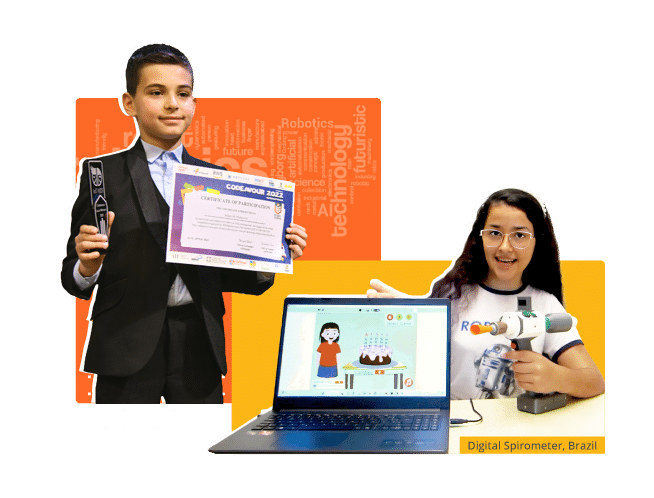
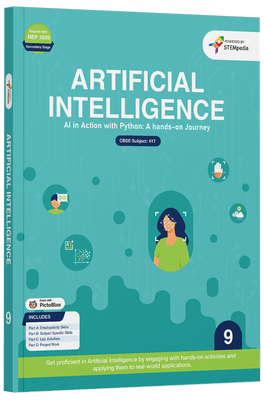
Get Your Book Today!
Artificial Intelligence is the book your child needs to start their journey in technology. Equip them with the skills of tomorrow, today!
FAQs on Artificial Intelligence - Class 9 Book
This book is tailored for Class 9 students as part of their CBSE curriculum. It aims to provide an in-depth understanding and appreciation of Artificial Intelligence (AI) and its significant role in our daily lives. The book balances theoretical knowledge with practical skills, particularly in Python programming and AI project development, thereby preparing students for academic and future career paths in the rapidly evolving tech world.
The “Artificial Intelligence (Code 417)” book is meticulously aligned with the Central Board of Secondary Education (CBSE) Skill Subject 417, which is a part of the Class 9 curriculum. This alignment is evident in various aspects of the book’s content, structure, and educational objectives:
- Curriculum Coverage: The book covers all the essential topics and modules as outlined in the CBSE AI curriculum for Class 9. This includes foundational concepts of AI, Python programming, neural networks, and practical applications of AI.
- Educational Objectives: The book’s objectives align with those set by CBSE, aiming to equip students with a comprehensive understanding of AI, its significance, and its practical applications. This alignment ensures that students are not only prepared for their academic examinations but also gain knowledge and skills that are relevant and up-to-date.
- Practical and Theoretical Balance: In line with CBSE’s emphasis on a balanced educational approach, the book integrates both theoretical knowledge and practical skills. It includes lab activities, project work, and programming exercises, mirroring the practical-heavy approach advocated by CBSE for skill subjects.
- Skill Development Focus: Consistent with CBSE’s skill-oriented education model, the book emphasizes developing employability skills alongside subject-specific AI knowledge. This includes communication skills, self-management, ICT skills, entrepreneurial skills, and green skills.
- Assessment Alignment: The structure of assessments and exercises in the book corresponds with the CBSE’s guidelines for Skill Subject 417. This includes a mix of multiple-choice questions, short answer questions, and practical project evaluations.
- Incorporation of AI Ethics: Aligning with CBSE’s recent focus on ethics in technology education, the book includes a section on AI ethics. This section ensures that students are not only technically proficient but also aware of the ethical implications of AI technologies.
- Use of Innovative Tools: The book’s use of tools like PictoBlox for practical learning is in line with CBSE’s emphasis on innovative and interactive learning methodologies. These tools make complex AI concepts accessible and engaging for Class 9 students.
- Real-World Application and SDGs: Reflecting CBSE’s focus on real-world applicability and alignment with Sustainable Development Goals (SDGs), the book includes project work and field visits. This approach encourages students to apply their learning in real-world scenarios and understand the broader impact of AI on society and the environment.
“Artificial Intelligence (Code 417)” is a comprehensive resource that is fully aligned with CBSE’s Skill Subject 417 for Class 9. It not only covers the required academic syllabus but also enriches students with practical skills and ethical understanding, preparing them for both academic success and future career paths in the field of AI.
The book is co-authored by Pankaj Kumar Verma and Akshat Srivastava. Pankaj Kumar Verma is the Chief Technology Officer at STEMpedia, holding a B.Tech degree from IIT Kanpur. Akshat Srivastava is an AI and Data Science Researcher at STEMpedia, with a B.Tech from Bennett University. Their combined expertise in AI and data science brings a wealth of knowledge and practical insight to the book.
The book’s content is meticulously divided into four parts:
- Part A: Employability Skills covers essential skills like communication, self-management, and ICT skills.
- Part B: Subject Specific Skills delves into core AI concepts, including an introduction to AI, AI project cycles, neural networks, and basics of Python programming.
- Part C: Practical Work emphasizes practical application through lab activities focusing on Python programming and machine learning.
- Part D: Project Work / Field Visit / Student Portfolio encourages students to apply their learning in real-world scenarios, aligned with Sustainable Development Goals.
PictoBlox is a graphical programming software introduced in the book. It’s used in several lab activities to teach coding and programming concepts. PictoBlox’s user-friendly interface makes it an effective tool for introducing students to programming, allowing them to create animations, games, and more.
Absolutely. The book is crafted with beginners in mind, offering detailed step-by-step guidance and activities. It introduces AI and programming concepts gradually, ensuring that students with no prior knowledge can follow along easily. The inclusion of practical exercises and projects helps solidify understanding and keeps students engaged.
The book encourages students to apply AI knowledge in real-world contexts, fostering responsible innovation and problem-solving skills. By aligning project work with Sustainable Development Goals, students are encouraged to think about the broader impact of technology on society and the environment. This approach helps in cultivating a sense of global responsibility and ethical thinking among young learners.
Upon completing this course, students are expected to:
- Gain a thorough understanding of AI and its practical applications.
- Develop skills in Python programming and AI project development.
- Enhance problem-solving abilities and logical thinking.
- Understand the ethical implications and responsibilities associated with AI.
- Be prepared for future academic and career paths in technology.
The book includes a wide array of activities and projects:
- Lab Activities: These focus on Python programming and machine learning concepts, providing hands-on experience.
- AI Projects: Students engage in projects that apply AI concepts to real-world scenarios, enhancing their understanding and creativity.
- Challenging Exercises: These are designed to test and enhance comprehension of the topics covered.
As of its first edition in 2023, the book includes contemporary content that reflects the current state of AI. It is designed to engage students with modern technological trends and the latest developments in the field.
Besides AI and programming, the book focuses on developing employability skills such as communication, self-management, ICT, entrepreneurial, and green skills. These skills are critical for students’ overall development and future career readiness.
It revisits AI basics and delves into Machine Learning, exploring types, model types in ML, and practical applications using PictoBlox. The book also discusses AI’s contribution to national development and its ethical considerations.
While the book is designed with classroom instruction in mind, its clear structure and comprehensive content also make it suitable for self-study. Students who are motivated and disciplined can use this book to learn independently.

